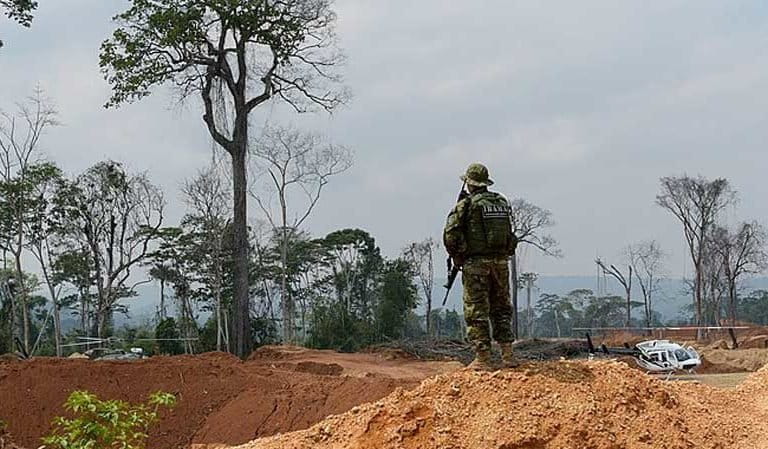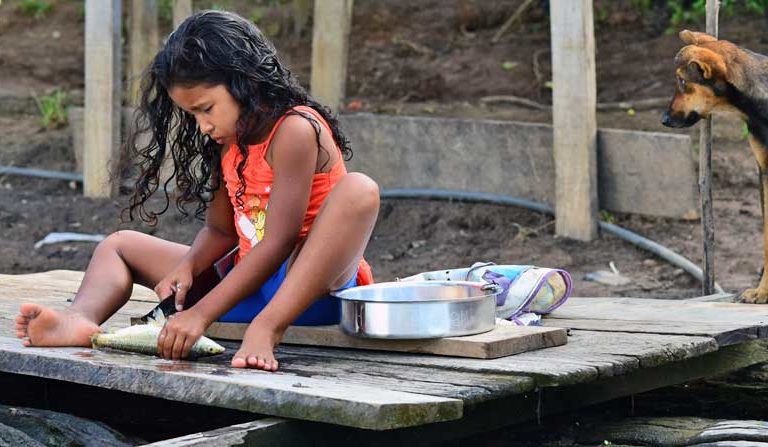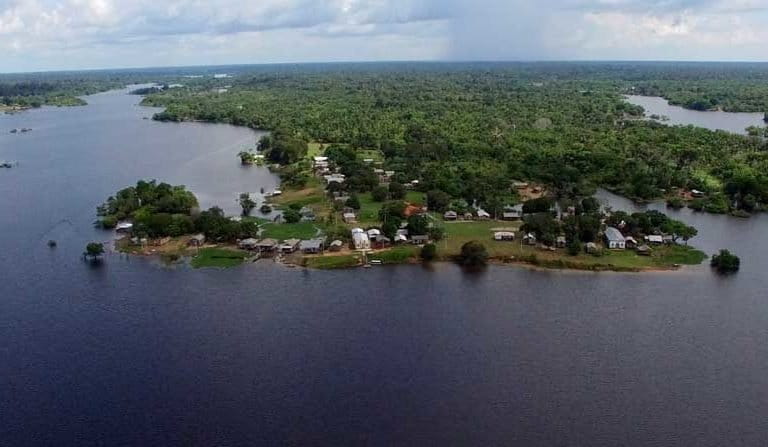Newsletter 2020-01-02
FEATURED
Bolsonaro’s Brazil: 2020 could see revived Amazon mining assault — part two by Sue Branford and Thais Borges [12/31/2019]
 |
– President Michel Temer issued a presidential decree in 2017 to open up the vast 4.6 million hectare (17,800 square mile) RENCA preserve in the northern Amazon to mining. Meeting with a firestorm of criticism he abandoned the effort. Sources now say the Bolsonaro administration is poised to quietly revive plans to open RENCA in 2020.
– Likewise, with Bolsonaro in charge, transnational mining companies are pushing for a change in Brazilian law allowing the firms to mine inside protected lands and indigenous reserves across the nation. The change could be introduced in 2020 via the mining law, a bill long stalled in Congress.
– Should mines in RENCA and elsewhere go ahead, transport will be needed. The planned Ferrovia Pará railway (Fepasa) would move commodities from Pará state’s interior for river transport to the coast. Other plans call for 20+ new river ports, 2 thermoelectric power stations, and a transmission line crossing Pará.
– However, all these major projects face a legal hurdle. The Brazilian Constitution states that no major measure can be authorized allowing mining in indigenous areas, or large new infrastructure projects approved before prerequisites are satisfied, including consent of affected indigenous and traditional communities.
Bolsonaro’s Brazil: 2019 brings death by 1,000 cuts to Amazon — part one by Sue Branford and Thais Borges [12/30/2019]
 |
– While the media focused in 2019 on Brazilian President Jair Bolsonaro’s incendiary remarks, or on the Amazon fires, he has quietly instituted new policies likely to aid land grabbers and do great harm to Amazon forests, indigenous and traditional peoples. “Death by 1,000 Cuts” parts 1 and 2 reviews those policies.
– Executive decree MP 910 issued December 11 legalizes large-scale land grabbing. The large-owner loophole built into the new decree allows land speculators to register large swathes of public lands that they grabbed before December 2018, using the illegal deforestation they accomplished as proof of their “occupation.”
– MP 910 could transfer 40-60 million hectares of public land to private owners who would then be authorized to legally deforest a fifth of that land, about 10 million hectares, experts say. MP 910 is likely to trigger high rates of conflict and deforestation. Congress must approve MP 910 in 120 days to make it permanent.
– The agriculture ministry also chose to make secret part of its ranching database, thwarting Visipec, an NGO-designed tool for tracking cattle raised on calving ranches where major deforestation occurs. Other administrative measures benefit big agribusiness over small family farms, and muzzle civil society voices.
Rainforests in 2020: 10 things to watch by Rhett A. Butler [12/29/2019]
 |
– This is Mongabay founder Rhett Butler’s annual look ahead at the year in rainforests.
– After a decade of increased deforestation, broken commitments, and hundreds of murders of rainforest defenders, the 2020s open as a dark moment for the world’s rainforests.
– Here are some key things to watch for the coming year: Brazil, destabilization of tropical forests, U.S. elections, the global economy, Jokowi’s new administration in Indonesia, market-based conservation initiatives, zero deforestation commitments, ambition on addressing the biodiversity crisis, Congo Basin, and assessment of 2019’s damage.
– Share your thoughts via the comment function at the bottom of the post.
2019: The year rainforests burned by Rhett A. Butler [12/27/2019]
 |
– 2019 closed out a “lost decade” for the world’s tropical forests, with surging deforestation from Brazil to the Congo Basin, environmental policy roll-backs, assaults on environmental defenders, abandoned conservation commitments, and fires burning through rainforests on four continents.
– The following review covers some of the biggest rainforest storylines for the year.
Amazon’s Mura indigenous group demands input over giant mining project by Thais Borges; Sue Branford; and Mauricio Torres [12/27/2019]
 |
– In 2013, Potássio do Brasil, a subsidiary of the Canadian merchant bank, Forbes & Manhattan, began drilling exploratory wells for a giant potassium mine — a highly profitable venture that would allow transport of potash along the Amazon and Madeira rivers. Potash is a vital fertilizer for Brazil’s rapidly growing soy agribusiness industry.
– One big problem: the company was reportedly drilling inside the Jauary Indigenous Reserve and directly adjacent to other indigenous reserves and communities. Indigenous people said that the ancestral lands being drilled, though sometimes not demarcated as being within their reserves, were vital for hunting and other livelihoods.
– The mine was licensed in 2015. However, legal irregularities resulted in the project stalling. Finally, a court settlement was reached in which the Mura communities would be given the legal right of consultation — a democratic process of self-determination guaranteed under international law rarely practiced in the remote Brazilian Amazon.
– How the Mura will vote — and whether that vote will be respected by municipal, state and federal governments; agribusiness; a transnational mining giant; and international investors — remains to be seen. However, analysts agree that the result could have far reaching consequences for rural traditional settlements across the Amazon.
Photos: Top 15 new species of 2019 by Shreya Dasgupta [12/26/2019]
 |
– In 2019, Mongabay covered several announcements of new-to-science species.
– The “discovery” of a new-to-science species is always an awe-inspiring bit of news; the outcome of dogged perseverance, months or years of field surveys, and long periods of sifting through hundreds of museum records.
– In no particular order, we present our 15 top picks.
Mega-mining project slated for Brazilian Amazon sparks controversy by Thais Borges; Sue Branford; and Mauricio Torres [12/26/2019]
 |
– Potássio do Brasil, a mining company; Autazes municipal authorities; the federal and Amazonas state governments; and large-scale soy growers all want one thing: to open a potash mine in the town of Autazes that would supply soy producers with Brazilian fertilizer, so as not to buy and pay for imported potash. All stand to profit.
– There’s just one major roadblock: the potassium deposits are on indigenous land, and the mining company started off on the wrong foot in 2013 by digging exploratory wells in secret, without getting indigenous permission to dig on their land.
– Years of acrimonious conflict and legal battles followed. The municipality of Autazes includes 12,000 Mura Indians among its citizens, most of whom live in one of the 20 indigenous reserves that have been officially demarcated or are in the process of being demarcated. They fear the potash mine’s social and environmental repercussions.
– They have successfully stalled the US$2.5 billion mining project up to now. But under the government of Jair Bolsonaro, the possibility that the potash mine could go forward without indigenous consultation — as required by international law — is becoming a looming possibility.
NEWS
‘Rediscovered’ after 100 years, Gurney’s pitta is in peril once again by Megan Stannard [01/02/2020]
– The last remaining habitat of the rare Gurney’s pitta in Myanmar is fast disappearing, a new study has found.
– Between 1999 and 2017, more than 80% of the bird’s habitat in Myanmar’s southern Tanintharyi region was lost, mostly due to clearance for oil palm plantations.
– The researchers also found no evidence of the bird’s presence in 101 of 142 local sites where it had previously been observed.
– The study calls for the IUCN to reclassify Gurney’s pitta as critically endangered.
Environmental damage exacerbates Jakarta flooding amid record rainfall by Basten Gokkon [01/02/2020]
– Record-breaking rainfall hit Jakarta and its satellite cities on New Year’s Eve, causing widespread flooding and leading to at least 19 deaths, authorities reported.
– Officials have attributed the severity of the disaster to years of environmental damage and waste dumping in the city’s rivers.
– The disaster has displaced more than 30,000 people, shut down an airport, and cut off some roads. More heavy rain is forecast through to next week.
Concerns about radioactive contamination dog Rio Tinto’s Madagascar mine by Malavika Vyawahare [12/31/2019]
– The Rio Tinto-owned QMM mine in southeast Madagascar could be polluting water sources in the region with radioactive contaminants, activists say.
– Elevated background levels of radioactive uranium and thorium, and lead in water bodies near the mine, are most likely a result of mining activity, according to new analysis released by the Andrew Lees Trust UK.
– The company has refuted claims that it is responsible for high radiation levels in the environment, attributing them instead to the natural sources of radioactivity in the area.
– The lack of agreement about the existence and nature of the contamination means there is no clarity about remedial measures and who is responsible for providing safe drinking water to about 15,000 local people whose water sources could have been compromised.
Balancing short and long term interests vital for Sri Lanka in 2020 (Commentary) by Nalaka Gunawardene [12/31/2019]
– To cope with unprecedented trends and uncertain futures, the island needs clear, well-coordinated conservation and climate policies. As the new administration reviews and realigns policies, 2020 provides an opportunity for Sri Lanka to balance economic growth with sustainability and climate resilience.
– To cope with unprecedented trends and uncertain futures, the island needs clear, well-coordinated conservation and climate policies.
– Sri Lanka’s new president plans to increase the national forest cover by 30%, initiate strategic environmental assessments at district level, and promote new infrastructure development as either ‘green and smart cities’ or ‘disaster resilient villages,’ according to his manifesto.
– This post is a commentary. The views expressed are those of the author, not necessarily Mongabay.
Our top nature drone photos of 2019 (Insider) by Rhett A. Butler [12/30/2019]
– Mongabay founder Rhett A. Butler chooses some of his favorite drone images captured in 2019.
– While I’ve written about use of drones in conservation since 2012, 2019 was the first year that I actually had drone myself I made a lot of use of it during trips to Bolivia, Indonesia, Mexico, and Madagascar as well as at home in the United States,
– This post is insider content, which is available to paying subscribers.
Illegal tin mining leaves trail of ruin in protected Brazilian rainforest by Ana Ionova [12/30/2019]
– Floresta Nacional de Altamira (Flona de Altamira) spans some 724,965 hectares in the state of Pará, and is home to a rich diversity of plants and animals, including several species threatened with extinction.
– Recently, an influx of illegal mining has led to rampant deforestation and the sullying of rivers. The miners are targeting the mineral cassiterite, the main ore of tin. Illegal ranching and road construction are also causing deforestation in Flona de Altamira.
– The government intervened earlier this year to put a stop to the mining, but satellite imagery shows deforestation around mining sites has picked back up since October.
– Conservationists and activists worry the rhetoric and policy changes of the Bolsonaro administration are encouraging the invasions of Flona de Altamira and other protected areas that provide important refuges for Brazil’s wildlife and indigenous communities.
Palm oil, fire pushing protected areas in Honduras to the ‘point of no return’ by Leonardo Guevara and Lesly Frazier [12/30/2019]
– According to the Honduran Ministry of Agriculture and Livestock (SAG), 190,000 hectares of oil palm are being cultivated in Honduras. They extend from the Cortés department to the Colón department along the country’s Atlantic coast.
– African oil palm has taken over 20 and 30 percent of the land in Punta Izopo National Park and Jeanette Kawas National Park, respectively.
– In 2016, a fire in Jeanette Kawas National Park consumed 412 hectares of land. Fire also damaged Punta Izopo National Park in August 2019.
Habitat loss drives deadly conflict in Indonesia’s tiger country by Taufik Wijaya [12/30/2019]
– In separate incidents in November and December, tigers killed five people in Indonesia’s South Sumatra province.
– The recent increase in human-tiger conflict has surprised many people in the area, who say they have long had a harmonious relationship with the animals.
– Conservationists say a key driver of human-tiger conflicts is habitat degradation due development projects like roads, housing, plantations and mining.
Brazil knows how to fight Amazon deforestation: Monitoring and law enforcement must be strengthened (commentary) by Juliano Assunção and Clarissa Gandour [12/30/2019]
– Brazil holds unique expertise in using policy to fight deforestation, largely due to the implementation of a policy action plan in the early 2000s. The plan proposed novel policy measures that helped reduce deforestation rates by more than 80% over the course of a decade.
– One of the action plan’s most salient innovations was the adoption of a novel monitoring and law enforcement strategy, which introduced satellite-based forest monitoring to target enforcement action. Data analysis indicates that this strategy avoided the clearing of an average of 27,000 km2 of Amazon forest per year from 2007 through 2016.
– The effectiveness of the monitoring and law enforcement strategy in combating deforestation did not impose a high cost burden: forest protection did not jeopardize local agricultural production, and its expected benefits outweighed the associated policy costs. Brazil must draw on what it has learned from the past to strengthen Amazon conservation today.
– This post is a commentary. The views expressed are those of the authors, not necessarily Mongabay.
Alarm over mass vulture poisoning in South Africa by Fred Kockott [12/29/2019]
– Fifteen white-backed vultures (Gyps africanus) and a young lappet-faced vulture (Torgos tracheliotos) have died after feeding on a poison-laced impala carcass in northern Zululand on 23 Dec — the fourth such incident in the province in 2019.
– The heads and feet had been removed from 13 of the dead birds, their bodies concealed in thick bush: experts warn that deliberate poisoning of vultures for belief-based use is on the increase in South Africa’s KwaZulu-Natal province.
– More than 1,200 vultures were deliberately poisoned across Southern and Eastern Africa this year, according to the Endangered Wildlife Trust.
Global consumer demands fuel the extinction crisis facing the world’s primates by Alejandro Estrada and Paul A. Garber [12/29/2019]
– Alejandro Estrada of the Institute of Biology at the National Autonomous University of Mexico and Paul A. Garber of the Department of Anthropology at the University of Illinois-Urbana argue that human consumption patterns are driving primates to the brink of extinction.
– Commodity production, extraction, and consumption are taking a heavy toll on key primates habitats around the world.
– This post is a guest analysis. The views expressed are those of the authors, not necessarily Mongabay.
In other news: Environmental stories from around the web, December 27, 2019 by Mongabay.com [12/27/2019]
– There are many important conservation and environmental stories Mongabay isn’t able to cover.
– Here’s a digest of some of the significant developments from the week.
– If you think we’ve missed something, feel free to add it in the comments.
– Mongabay does not vet the news sources below, nor does the inclusion of a story on this list imply an endorsement of its content.
Love triangle complicates efforts to breed Sumatran rhinos by Basten Gokkon [12/27/2019]
– Efforts to breed the critically endangered Sumatran rhino in captivity have faced myriad challenges ranging from mysterious deaths and reproductive health problems to bureaucratic hurdles.
– Now, a sanctuary in Indonesia that has previously witnessed the birth of two healthy calves is facing a new, unexpected obstacle: relationship problems.
– One pair of rhinos, Andalas and Ratu, have successfully produced two calves. But after keepers attempted to mate Andalas with a second female, his previous mate now rejects him.
– Producing as many calves from the captive rhinos is a top priority in efforts to conserve the species, whose wild population is fewer than 80 individuals.
Cambodian “bat man” bolsters the fight against dengue fever by Claire Baker-Munton [12/26/2019]
– Rising temperatures due to climate change allow mosquitoes carrying deadly malaria and dengue fever to live in new parts of the world that were previously uninhabitable, placing over half the world’s population at risk.
– Creating artificial roosts for bats to “farm” their guano can improve soil quality, providing a natural fertilizer while reducing insect numbers, and possibly disease burdens.
PREVIOUS FEATURES
Antonio Donato Nobre: “The forest is sick and losing its carbon-sequestration capacity” by Sibélia Zanon [12/23/2019]
Brazil on the precipice: from environmental leader to despoiler (2010-2020) by Sue Branford and Thais Borges [12/23/2019]
Deforestation for potential rubber plantation raises concerns in Papua New Guinea by John C. Cannon [12/19/2019]